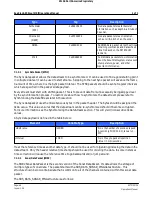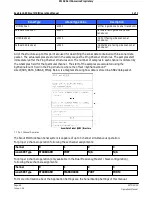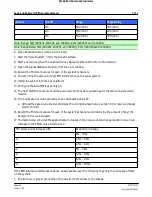
ATLAS North America Proprietary
Sea Scan ARC Scout MKII Operations Manual
1 of 1
Page: 52
Issue: 1.2.4
SCTM2-OPS
Operations Manual
Type
Value
Description
Over Temp.
0x01
This bit is set when the maximum
temperature has been exceeded.
Over Volt
0x02
This bit is set when the maximum
voltage has been exceeded.
Over Current
0x04
This bit is set when the maximum
current has been exceeded.
If any of the warning bits are set, the system will continue to operate. However, any alarm flags will cause
an interruption in the data collection. The system must have all alarms corrected and rebooted prior to
continuing normal operations. The Scout MkII will have to be reset and the condition cleared in order to
clear the alarm.
7.1.4
Synchronizing the Sonar Data Stream
There are two specific times at which you must synchronize the sonar data stream. When a program first
starts reading data from its data connection, and then when a sonar data stream becomes unsynchronized
(i.e. header checksum fails, etc.).
In order to synchronize the data stream, start by parsing the stream for the serial synchronization bit stream
(0x53594E43AAAAAA) which is 56 bits long. The bit stream consists of the SYNC tag and the serial
synchronization DWORD. This unique bit stream identifies a SYNC packet. After the synchronization bit
stream is confirmed, the data payload size recorded in the dwSize variable should be verified against the
size of the SYNC data structure. Now rewind to the start of the packet header and confirm that the header is
valid. Then read the reference time stamp to get the exact date and time of this packet as well as when to
expect the next SYNC packet.
7.2
SDS Over UDP
Streaming SDS data over UDP/IP is straight forward. The Scout MkII uses UDP port 1409. The Scout MkII will
include 1 SDS packet per UDP packet. The SDS header will be the first data structure in a UDP data packet
payload. Some SDS data will require more than one UDP packet due to the network's maximum transmit
unit (MTU). For the Scout MkII this is 1472 bytes (1500 bytes - UDP packet header size). This mostly applies
to the SNR2 data packets.
The 1 SDS packet per UDP packet rule is advantageous when synchronizing the data stream. When
synchronizing from a file every byte needs to be checked to see if it contains synchronization data.
However since UDP packets always start with a SDS header only one check for synchronization data needs
to be made. This speeds the synchronization process up considerably.
7.3
Saving SDS Data In Files
The data received over a UDP network connection can be written directly into a binary file with a .SDS file
extension.
A file must start with a SYNC packet. If the file does not then Sea Scan Survey will skip over any data until it
finds a SYNC packet. This will result in apparent loss of data.
File size can be controlled by recording X amount of time in a packet, X amount of pings (Sonar Data
Packets), or file size (in Bytes). Sea Scan Survey saves 1 hour per file by default. This creates rather large
files (in excess of 1 GB). For ease of file handling we recommend no more than 15 minutes per file. Since
the file size is controlled by time the SYNC packets can be counted. The Scout MkII sends 1 SYNC packet per































